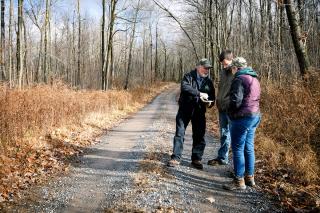Using our nation’s forest inventory to open carbon markets to family forest owners
Joyce El Kouarti

Susan Benedict, right, a landowner enrolled in the Family Forest Carbon Program, meets with her forester. In many cases, timber sales don’t provide enough money to support a property, which can put pressure on the option to sell and convert the land from forest. The Family Forest Carbon Program helps keep forests as forests. Courtesy photo from the American Forest Foundation.
Maintaining trees and forests on the landscape is a powerful way to sequester carbon over the long term. Carbon markets could help; these trading systems enable landowners to sell carbon credits to individuals and corporations seeking to enhance the conservation of forests and their associated carbon benefits.
Large landowners typically possess the resources needed to inventory and estimate the variety of forest attributes needed to enter carbon markets. However, there are currently few opportunities for the owners of small private forests to receive payment for their carbon benefits. Part of the challenge is the cost of data and reporting requirements of the carbon registries currently operating in the United States.
However, the USDA Forest Service Forest Inventory and Analysis program, also referred to as FIA, collects data from survey plots across the country at a scale that may be able to help. Program field crews gather detailed data, such as the species, diameter and ages of individual trees, as well as broader information about forest health and disturbance history. Researchers can then use this information to build models that allow researchers to assess much smaller areas, lowering the hurdles for owners of smaller parcels to meet carbon market requirements.
Families and individuals own the largest portion of America’s forests—39%—in small parcels from 10 to 2,000 acres. Collectively they own 290 million acres, an amount that has the potential to influence the amount of carbon storage in forests nationally. By comparison, the Forest Service manages 193 million acres of public lands, of which 144 million acres are forest.
The Forest Service works with partners to help bring the benefits of data from the FIA program directly to owners and managers of family forests. A new program developed by the American Forest Foundation and The Nature Conservancy uses the data combined with modeling and analysis to help owners of small forests participate in the carbon market.
“The value of the FIA data cannot be underscored,” said Linda Heath, acting deputy chief of Research and Development at the Forest Service . “This publicly available data source, the only one of its kind, can help landowners make well-informed land management decisions for forests of the United States. We applaud the American Forests Foundation and The Nature Conservancy for their partnership to provide family forest owners valuable information about how to ensure the health of their forests, which contributes to the health of the Nation.”

Not only do landowners in the Family Forest Carbon Program receive payments to management implement practices that store carbon and improve forest health, but they also have access to professional foresters who can help them write forest management plans tailored to their specific goals. Here a forester meets with landowners to take measurements to match enrolled properties to FIA plots. Courtesy photo from the American Forest Foundation.
The Family Forest Carbon Program is uniquely designed for family forest owners with forested properties as small as 30 acres. Historically, the forest carbon market has only been accessible to large landowners who own 5,000 acres or more.
“There’s a perception that only large timber management companies benefit from FIA’s work,” said Tom Brandeis, a Forest Service supervisory research forester. “However, this program demonstrates that FIA data provides great utility for small landowners as well.”
The carbon stored by enrolled forests is measured and verified by a new forest carbon accounting methodology that compares the carbon stored on lands enrolled in the Family Forest Carbon Program to highly comparable inventoried plots not enrolled in the program. The Family Forest Carbon Program sells the additional stored carbon benefit as verified carbon credits to companies seeking to neutralize their residual or supply-chain emissions. This methodology was approved by Verra’s Verified Carbon Standard in October 2022.
Participation in carbon markets can help forest owners afford the practices needed to improve forest health and wildlife habitat. Enrolled landowners in the Family Forest Carbon Program receive annual payments to implement forest management practices that enhance carbon storage, improve forest health, and provide other important natural resource benefits.
“Timber sales often don’t provide enough money to support a property,” said Susan Benedict, a landowner enrolled in the Program. “It’s been my experience that as ownership moves out from the original owner, the property gets sold and often converted from forest if there isn’t cash to support it. Carbon programs like this provide some income to landowners.”
Brandeis is pleased to see the Forest Service’s Inventory and Analysis data applied in new ways that provide the greatest benefit to those in greatest need. This approach removes costly participation expenses for landowners and even increases accuracy as to how much carbon can be attributed to a specific carbon intervention.
“Family forest owners have the potential to make a big impact on mitigating climate change, but the cost of measurement has always been a barrier” said Christine Cadigan, executive vice president for carbon origination for the American Forest Foundation. “The Forest Service’s FIA data has really changed that – opening the doors to carbon markets for thousands of forest owners.”